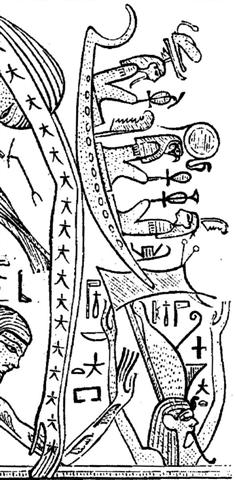Obviously we need the stars also of the Foal, but
first we should complete our Pegasus investigation. Homan
was not only ζ but also ξ
according to Ulug Beg. The distance from ζ to ξ is 4 days
(an exteded pair) and in this interval there are 3 other stars, viz.
ο, η (Matar), and λ:
|
Saad
Balaa 3 (288) |
|
Leap night |
|
4 |
|
February 28 (59) |
29
(425) |
March 1 |
 |
 |
 |
|
Ca13-1 (344) |
Ca13-2 |
Ca13-3 |
|
Kua haga te
tagata |
kua haga |
e kua noi |
|
ο
Pegasi (343.8, Matar (344.2) |
Leap night |
λ
Pegasi (345.0), ξ
Pegasi (345.1) |
|
August 30 (242) |
31 |
September 1 (609) |
|
Alterf 1 (106) |
2 |
3 |
|
Vathorz Posterior
(162.1) |
Peregrini, η Carinae
(162.6), ν Hydrae (163.1) |
no star listed |
Altair (609) |
Around 1720 A.D. these 4 Pegasus stars
would have been earlier than the leap from February 28 to
March 1.
Beyond the following 5 Pegasus stars in 4 days
of early March there was none in the following 4 days:
|
Saad Balaa 5 |
6 |
7 |
|
8 (293) |
3 |
|
March 2 |
3 (63) |
4 (429) |
5 |
 |
 |
 |
 |
|
Ca13-4 |
Ca13-5 (348) |
Ca13-6 |
Ca13-7 (350) |
|
tagata
ma te kihikihi |
koia
ra kua oho |
manu
rere |
|
τ Aquarii (345.7),
μ
Pegasi (345.9),
ι Cephei (346.0), γ
Piscis Austrini, λ Aquarii, σ
Pegasi (346.5) |
Scheat Aquarii (347.0),
ρ
Pegasi (347.2,
δ Piscis Austrini (347.4) |
Fomalhaut (347.8) |
Scheat Pegasi,
π Piscis Austrini (349.3),
Markab Pegasi (349.5) |
|
September 2 |
3 |
4 |
5 (248) |
|
Alterf 4 |
5 (140) |
6 |
7 |
|
no star
listed |
Alkes
(165.6), Merak (166.2) |
11h (167.4) |
no star
listed |
|
Dubhe (166.7) |
|
Saad Balaa 12 |
13 |
Saad Al Saud 1 |
2 (300) |
3 |
|
March 9 |
10 (70) |
11 |
12 |
13 |
 |
 |
 |
 |
 |
|
Ca13-11
(354) |
Ca13-12 |
Ca13-13 |
Ca13-14 |
Ca13-15 |
|
e toru
gagata, tuhuga nui, tuhuga roa,
tuhuga marakapa
(Jaussen:
kapa chant) - ma te
hokohuki te tapamea - te kihikihi |
te
vaha erua - te maro |
tagata kara te roturotu - te maro |
ka pu te niu - mai
tae huki hia |
ka pu te niu |
|
χ Aquarii (352.6), ο Cephei (353.3) |
Kerb (353.6) |
υ
Pegasi (354.9) |
no star listed |
ι Phoenicis (357.3) |
|
September 9 |
10 |
11 |
12 |
13 (256) |
|
Alterf
11 |
12 |
13 |
Dschuba 1 |
2 (120) |
|
κ
Crateris (172.5) |
no
star listed |
ο¹
Centauri (173.8), ξ Hydrae (174.3) |
ο²
Centauri, λ Centauri (174.8), θ
Crateris (175.0), ω Virginis
(175.3), ι Crateris (175.5 |
ο
Hydrae (176 |
And beyond Kerb and υ
Pegasi there was a week to φ
Pegasi:
|
Saad Al Saud 4 |
5 (303) |
6 |
|
March 14 (π) |
15 |
16 |
 |
 |
 |
|
Ca13-16 (359) |
Ca13-17 |
Ca13-18 |
|
oho te vae |
tagata
puoko erua |
tagata puo pouo |
|
Alrai, θ Phoenicis (358.4) |
ω Aquarii (359.2) |
σ Phoenicis (360.4) |
|
September 14 (257) |
15 |
16 (624) |
|
Dschuba 3 (121) |
4 |
5 |
|
ζ Crateris, ξ Virginis
(177.0), λ Muscae (177.1), ν
Virginis (177.2) |
μ Muscae (177.8), 93 Leonis
(178.0), Denebola (178.3) |
Alaraph (178.6), Phekda, β
Hydrae (179.3) |
Deneb Cygni (624) |
|
Saad Al Saud 7 |
|
8 (306) |
|
March 17 (77) |
18 (443) |
 |
 |
|
Ca13-19 |
Ca13-20 (363) |
|
vero
hia |
- |
|
no star listed |
φ
Pegasi (361.7) |
Acubens (442) |
|
September 17 (260) |
18 |
|
Dschuba 6 |
7 (125) |
|
η Crateris (179.9) |
π Virginis (181.0) |
Glyph 363 was
probably designed to
illustrate half a day. 15 * 29½
= 442½. The half which is
visible seems to be down in
Toga (southwest).
Then, with the
beginning of line Ca14, the last
3 Pegasus stars were possible to
arrange in parallel with RA
days 364-368:
|
Saad Al Saud 9 |
10 |
11 |
12 (310) |
13 |
|
March 19 |
20 |
21 (81) |
22 |
23 (448) |
 |
 |
 |
 |
 |
|
*Ca14-1 |
*Ca14-2 |
*Ca14-3 |
*Ca14-4 |
*Ca14-5 (368) |
|
Kua
tupu te ata i
te henua |
|
ψ
Pegasi (363.1),
π Phoenicis (363.4) |
τ Phoenicis (363.9) |
0h |
ε Phoenicis (0.8) |
Algenib Pegasi
(1.8), χ
Pegasi (2.1) |
|
Caph, Sirrah (0.5) |
|
September 19 |
20 |
21 |
22 (265) |
23 |
|
Dschuba 8 |
9 |
10 (128) |
11 |
12 |
|
ο Virginis (182.1) |
12h (182.6) |
Minkar (183.7),
ρ Centauri (183.9) |
Pálida (184.6),
Megrez (184.9),
Gienah (185.1),
ε Muscae (185.2) |
Zaniah (185.9),
Chang Sha (186.3) |
|
Alchita, Ma
Wei (183.1) |
The glyph at
March 20 (80) perhaps is
meant to illustrate the
curve at the end, a Sign
which is the opposite of the
straight point in front:
|













